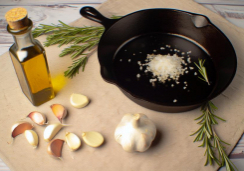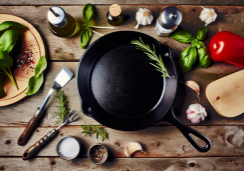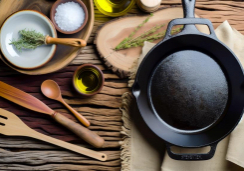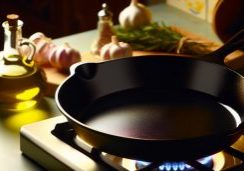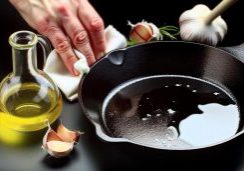What's the Best Way to Season a Cast Iron Skillet?
You've likely heard various theories on the best way to season a cast iron skillet, with each method promising to achieve that coveted non-stick surface. As you stand in your kitchen, armed with your skillet and a bottle of oil, you might wonder if there's a definitive answer to this culinary conundrum.
While the basic steps involve cleaning, oiling, and heating your skillet, the devil, as they say, is in the details. You'll need to choose the right oil, apply it with a technique that avoids common pitfalls, and find the precise temperature that does the trick without smoking out your kitchen.
It's a process that begs for precision and patience, but before you take the plunge, consider the variables that could mean the difference between a perfectly seasoned skillet and a sticky mess. Let's embark on a journey to unravel the secrets of seasoning, where even a slight misstep can turn culinary dreams into kitchen nightmares.
Understanding Skillet Seasoning
To ensure your cast iron skillet maintains its nonstick qualities, it's crucial to understand the process and importance of properly seasoning the cooking surface. Seasoning cast iron is fundamental to its performance, creating a natural, nonstick coating that improves with use. The seasoning process involves coating your pan with a thin layer of oil and heating it to form a bond. This layer of seasoning is essentially a layer of carbonized oil, a polymerization that renders it slick and durable.
When you season a cast iron skillet, you're not just going through the motions; you're building a legacy. Each session adds a layer, strengthening the seasoned pan. Begin by rubbing it with a film of neutral oil, then bake it upside down at 350°F for an hour. It's a ritual that pays off in longevity and ease of use.
To maintain this iron seasoning, cook with oil or fat and steer clear of acidic foods until your skillet is well-seasoned. After each use, apply a thin layer of oil to preserve the seasoned surface. Remember, the right oils make all the difference—vegetable, canola, flaxseed, grapeseed, or coconut oil are all excellent choices for a robust cast iron seasoning.
Preparing Your Skillet
Before seasoning your cast iron skillet, you'll need to prepare it by thoroughly scouring away any protective coating or residue under hot water. If your pan has rust, create a paste using salt and a bit of oil, and scrub the affected areas. This abrasive mixture helps to dislodge the rust without damaging the skillet's surface. After scrubbing, rinse the skillet thoroughly to ensure no soap or salt remains.
Next, dry your cast iron skillet completely. Once dry, it's time to coat the cookware with a thin layer of grease or oil. You can use a variety of fats for this process, but vegetable oil is a popular choice for its high smoke point and availability. Apply the oil sparingly; you want just enough to create a sheen on the surface without any excess. Use a paper towel to spread the oil evenly across the pan, covering every inch of the interior and exterior.
Applying the Oil
Having prepared your cast iron skillet, it's time to brush on a thin layer of neutral oil for the initial seasoning step. Choose an oil with a high smoke point, such as vegetable oil, canola oil, or melted shortening, to ensure that your layer of seasoning adheres well and remains stable during the heating process. Spread the oil evenly over the entire surface of the skillet, including the bottom and sides, to create a uniform thin layer. This is crucial for building up a durable, nonstick coating.
Next, you'll need to heat the skillet to bond the oil to the metal, forming the foundation of your seasoning. Place the oiled skillet upside down on the middle rack of your oven, preheated to between 450-500 degrees F. It's a good idea to put a baking sheet or aluminum foil on the rack beneath to catch any drips. Bake the skillet for about an hour, then let it cool in the oven.
Baking the Skillet
Once your oven reaches 350°F, place your oiled cast iron skillet upside down on the middle rack to begin the baking process. This crucial step transforms the thin layer of vegetable oil you've applied into a durable layer of seasoning. The heat allows the oil to polymerize and bond to the surface of your cast iron pan, creating the non-stick patina that seasoned cast iron cookware is renowned for.
As you bake the skillet, the oil undergoes a series of chemical reactions. You'll want to maintain the temperature between 450-500 degrees F, which is the optimal range for seasoning. This high heat ensures the oil breaks down and fully coats the skillet, enhancing its natural non-stick properties.
Keep the skillet in the oven for one hour, which allows a strong layer of seasoning to build up. It's a gradual process, but patience pays off with a well-seasoned pan that improves with each use.
After the hour is up, turn off the oven and let the skillet cool down completely inside. This slow cooling process further entrenches the seasoning, leaving you with a resilient, non-stick surface ready for cooking.
What Are the Best Seasoning Techniques for Cast Iron Skillets?
When it comes to cooking with cast iron skillets, using the latest seasoning techniques is key. Applying a thin layer of oil and heating the skillet in the oven can help create a strong, non-stick surface. Regularly seasoning your skillet will help maintain its quality and performance for years to come.
Maintaining Seasoning
To ensure your cast iron skillet retains its non-stick properties, regularly coat it with a thin layer of high smoke point oil after each use. This practice preserves the seasoned surface, preventing food from sticking and protecting against rust. When you're done cooking, let the skillet cool slightly, then apply a small amount of vegetable or canola oil to the surface. Rub it onto the entire skillet, creating a thorough layer of seasoning that will safeguard your cookware until its next use.
Occasionally, to further maintain the seasoning, you might need to re-season your cast iron. Start by cleaning the skillet well, then apply a thin layer of oil. Place your cookware in the oven and bake at 450-500 degrees F for one hour. This process reinforces the layer of seasoning, strengthening the bond to the iron and restoring the skillet's slick patina.
Be mindful to avoid cooking highly acidic foods or using abrasive scrubbers, as these can strip the seasoning. If you notice your skillet's performance diminishing, it may be time to apply this re-seasoning technique. By repeating the seasoning process two to three times, you'll achieve a durable, slick cooking surface that makes your cast iron a pleasure to cook with.
Conclusion
Now that you've seasoned your cast iron skillet, you'll enjoy a durable, non-stick surface that only gets better with time. Remember, keep it dry, lightly oiled, and give it a quick heat after washing to maintain that perfect patina.
With each use, you're building flavor and fortifying your skillet's legacy. So go ahead, cook with confidence and savor the rich tradition that cast iron brings to your kitchen.
Your skillet's ready for a lifetime of culinary adventures.

